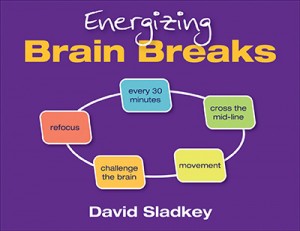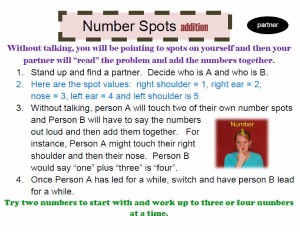Give ‘Em a Break
Energizing Brain Breaks
By David Sladkey
(Corwin Publishing, 2013 – Learn more)
Picture this scenario. You’re at an all-day workshop and all of a sudden your mind begins to wander. You start to think about the grocery list, what to make for dinner, and how much you wish that your presenter would let the group take a break.
In the back of your mind, you keep thinking, “All I need is five minutes to stretch and get out of my seat. Just five minutes. Is that too much to ask??” You keep looking at the clock and wonder how much longer can you endure sitting down. You love the workshop, but your mind is wandering because you need a break!
Unfortunately, this is what our students experience every day. It’s all too familiar. The glazed look in their eyes…the fidgeting in their seats…the “huh” answer to a question…the sigh of relief as the bell rings.
 Get ‘Em Moving with Brain Breaks
Get ‘Em Moving with Brain Breaks
David Sladkey, author of Energizing Brain Breaks, has been teaching high school mathematics since 1987. His practical “flip book” contains fifty effective brain break ideas that you can immediately apply at any grade level (or even if you are a facilitator at a workshop). One of the caveats of the book is that you don’t need any supplies, just students and a minute or two. Once the students are familiar with the brain breaks, all you need to do is mention the task and wait for instant success. It’s like a breath of fresh spring air after a long winter. Each of the activities are mentally challenging while getting your students to move.
What Research Shows
Theoretically, I knew that the brain research proved that students need a break at least every twenty minutes. Brain breaks are research based movements which allow more oxygen and energy to enter students’ brains.
I also knew from my own research and experience that although students looked as if they were paying attention, they sometimes had that “look in their eyes.” The look of “I need a break so I can understand what she is saying.” I also knew that most children are growing up in a media driven world and need to respond to the constant stimuli of computer driven games. So many of our student’s lives are centered indoors. Therefore, I realized that it is even more imperative that I expose my students, especially adolescents, to novel approaches to getting out of their seats in movement activities such as brain breaks.
How Students React
However, I was a bit skeptical in the beginning about using brain breaks more consistently. Would this cause the class to think it was a time to play? Would it be difficult to get them back into the lesson? Would I be losing time instead of gaining time? The only way to find out was to try it, and try it I did.
At first, my class looked at me with a different type of glazed look in their eyes. What is my teacher doing NOW? But after I explained the importance of giving ourselves time to take a break so that we could go onto the next task, it was smooth sailing.
One of my favorites is Number Spots: Multiplication (a sneaky way to have students remember their multiplication facts).
I have to admit, not all the activities may be suited for your classroom. Some of the activities involve getting down on the floor, and depending on your classroom floor and the time of year, you may opt out of doing this activity. However, most of the activities are easy to explain, fun to do, and take a minute or two. In the beginning, it may take a few extra minutes until the students know the steps of the activity but once you practice a few times, all you need to do is to name the activity and they are off on their own.
Using Brain Breaks in my class has helped my students to refocus and stay fresh. It gets them moving, laughing, and challenging themselves.
Why Brain Breaks Work
According the Mr. Sladkey: Ten Reason Brain Breaks Will Help You
- They get you up and moving.
- Your best thinking usually comes during a break.
- They engage both sides of your brain by crossing the midline.
- Your efficacy will rise.
- Activating your brain helps boost a positive attitude.
- They relive stress.
- Your body and brain tension will go down.
- New creative ideas happen during breaks.
- Stepping back will help you to step forward.
- Breaks help you to enjoy the moment.
What more can I say. GIVE ‘EM A BREAK and use Energizing Brain Breaks in your classroom.
Linda is a fifth grade teacher at Pond Road Middle School in Robbinsville, NJ, and a recipient of several educational grants that infuse a literacy enriched curriculum, along with an understanding of individual learning styles to help students understand bias and patterns of discrimination. She is a Teacher Consultant with the National Writing Project and a participant on the NJ Department of Education Teacher Advisory Panel.



































